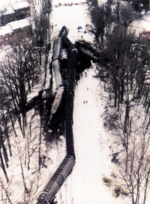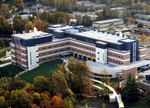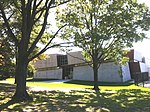Talbot Avenue bridge
African-American history of Montgomery County, MarylandBridges in Montgomery County, MarylandDowntown Silver Spring, MarylandHistory of MarylandMaryland building and structure stubs ... and 3 more
Maryland transportation stubsRoad bridges in MarylandSouthern United States bridge (structure) stubs

The Talbot Avenue bridge in Montgomery County, Maryland, was a historic one-lane metal girder bridge that connected the neighborhood of Lyttonsville to downtown Silver Spring. Built in 1918 and dismantled in 2019, the bridge had historic value as a connection from an antebellum community founded by a free Black laborer to neighborhoods where for decades Black people were allowed to work, but not live.As of 2022, its main span is in storage with plans to display it along the Georgetown Branch Trail.
Excerpt from the Wikipedia article Talbot Avenue bridge (License: CC BY-SA 3.0, Authors, Images).Talbot Avenue bridge
Talbot Avenue, Silver Spring Montgomery Hills
Geographical coordinates (GPS) Address External links Nearby Places Show on map
Geographical coordinates (GPS)
| Latitude | Longitude |
|---|---|
| N 39.00195 ° | E -77.04482 ° |
Address
Talbot Avenue
Talbot Avenue
20910 Silver Spring, Montgomery Hills
Maryland, United States
Open on Google Maps








